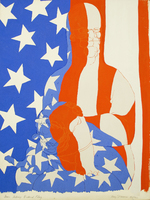May Stevens
1972
Gouache on paper
Sheet: 30 in. x 22 in.
Gift of Leonard & Ruth Bocour
May Stevens was born in 1924 in Quincy, Massachusetts.1 She attended the Massachusetts College of Art in Boston for her undergraduate education, after which she moved to New York City and began to teach at the New York City High School of Music and Art before she formally left after her request to take a sabbatical to focus on her personal work was denied.2 In this way, her commitment to her own work and its growing political concerns are made clear. Her most influential work was produced in New York in a period spanning the 1960s and 1970s and focused on issues of activism, feminism, and the civil rights movement. Through her exploration of these intersections, Stevens demonstrates an explicit relationship between art and activism. Her work Man Hiding Behind Flag, in the collection at St. Mary's College of Maryland, is a clear example of this connection.
Man Hiding Behind Flag is part of a larger group of work produced between 1967 and 1976 called the “Big Daddy” series.3 In the image, a large bald man with glasses is depicted as sitting with a bulldog in his lap, seemingly veiled by a vertically-hanging American flag. Steven’s style takes cues from the pop-art tradition through the use of simple line-work to depict the figure, and the highly saturated patriotic colors (red, blue, and white) superimposed onto the entirety of the image. By using her father as a model for a symbol of patriarchal power and racism in America, she blends the distinctions between the personal and public political in artistic expression.4 The male figure, “Big Daddy,” has a small and pudgy face centered on a long bald head, his benign smile and small squinted eyes give the impression of blissful or willing blindness to what is on the other side of the flag he is “hiding behind.” Other than the cover from the flag, he gives the impression of nudity. When considering this work in its temporal context of directly in the midst of the civil rights movement and Steven’s devoted involvement to the movement, his lack of clothing leaves his identity or social role ambiguous.5 His ambiguous identity, as well his physically hiding behind the flag, suggest that this figure could be any white male who benefits and supports systems of oppression disguised as patriotism. This particular work fits in well with the larger “Big Daddy” series, which is comprised of gouache drawings and acrylic on canvas paintings featuring the same character in various situations, often taking on the guise of a soldier or a policeman.
1. Priscilla Frank, “Meet May Stevens, A Feminist Civil Rights Activist Artist You Should Know,” The Huffington Post, August 14, 2014. Accessed September 23, 2016. http://www.huffingtonpost.com/2014/08/14/may-stevens_n_5649294.html↩
2. Mara R. Witzling, Voicing Today’s Visions: Writings by Contemporary Artists (New York: Universe Publishing, 1994), 66.↩
3. Tiernan Morgan, “Painting the Power of Patriarchy,” Hyperallergic, August 13, 2014. Accessed September 23, 2016. http://hyperallergic.com/143392/painting-the-power-of-patriarchy/ ↩
4. Lucy Lippard, “Masses and Meanings,” in May Stevens Ordinary/Extraordinary: a Summation 1977-1984 (Boston: Boston University Art Gallery, 1985), 2-11↩
5. Morgan, “Painting the Power of Patriarchy.”↩
-Emily Smith

